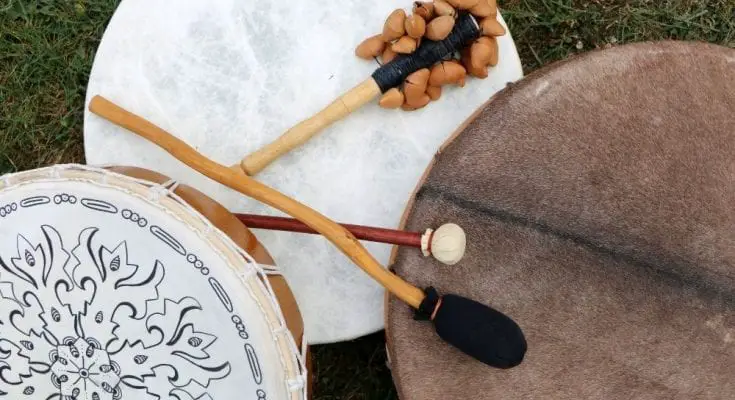In Native American culture, rattles have strong significance. They play an integral role in spiritual ceremonies, rituals, and shamanic journeying, amongst other things. If you’re interested in learning more about the uses of a shamanic rattle, keep on reading.
What Are Shamans?
To understand what a shamanic rattle is, it’s important to have some background knowledge on shamans. Shamans use rattles as an accompaniment to many of their ceremonies, rituals, and other duties. In traditional Native American societies, the shaman is a religious or mystical expert who functions as a healer, prophet, and a custodian of cultural tradition. In some societies, the shaman is the sole performer of these roles. In others, they’re merely a specialist. Shamans are supposed to use their powers to benefit the community, but in some cases, they were believed to use them for sorcery.
Traditionally, shamans use their powers to determine the outcome of hunts, locate lost objects, determine the root causes of communal discontent and ill will, and more. They’re also consulted at times of personal or communal sickness. If the root of the illness is determined to be caused by intrusive objects placed into the body by sorcery or spirit loss, the shaman is put in charge of the healing process. They remove the offending agent or restore the patient’s spirit and reintroduce it into the body. Modern shamans and shaman-led ceremonies still exist. Most modern-day shamans consider themselves facilitators for healing, rather than healers themselves. Like their ancestors, they perform rites of passage ceremonies, including births, marriages, and deaths.
What Are Shamanic Rattles, and What Are They Used for?
Rattles have multiple identities. They’re divine gifts, markers of identity, tools of magical intent, and musical instruments. They’re said to contain the voices of spirits who activate the healing properties and spiritual essences of herbs, beads, stones, and contain other, magical items. In Iroquois medicine societies, the sound of a rattle is described as the sound, or thoughts, of the Creator. The making of shamanic rattles is a long process. Just like drums, they’re crafted carefully and with respect.
The uses of a shamanic rattle are vast. To most shamans, rattles are beings of the water. They represent a cleansing energy, like rain washing down upon the body. They’re used to invoke the assistance of power animals and helping spirits and can direct energy, much like a magician wielding a magic wand. Energy, often possessing healing capabilities, can be mentally transmitted through the rattle and into the environment or someone’s body. Along with their healing properties, rattles can be used to signal the beginning of an important prayer or to communicate with the spirits of ancestors. Through the rattle, prayers, thoughts, and intentions can be broadcasted into the spirit world. When they’re being used as instruments, rattles are typically accompanied by the sound of drums. The shaking of the rattle and beat of the drum, when paired together, can help induce trance states. This makes them useful for healing ceremonies and for guiding the shamanic journeying process.
FAQ
What are shamans?
To understand what a shamanic rattle is, it’s important to have some background knowledge on shamans. Shamans use rattles as an accompaniment to many of their ceremonies, rituals, and other duties. In traditional Native American societies, the shaman is a religious or mystical expert who functions as a healer, prophet, and a custodian of cultural tradition. In some societies, the shaman is the sole performer of these roles. In others, they’re merely a specialist. Shamans are supposed to use their powers to benefit the community, but in some cases, they were believed to use them for sorcery.
What is a shamanic rattle?
Rattles have multiple identities. They’re divine gifts, markers of identity, tools of magical intent, and musical instruments. They’re said to contain the voices of spirits who activate the healing properties and spiritual essences of herbs, beads, stones, and contain other, magical items. In Iroquois medicine societies, the sound of a rattle is described as the sound, or thoughts, of the Creator. The making of shamanic rattles is a long process. Just like drums, they’re crafted carefully and with respect.
Additional Resources:
Tool
CBD Salve
CBD Massage Oil



